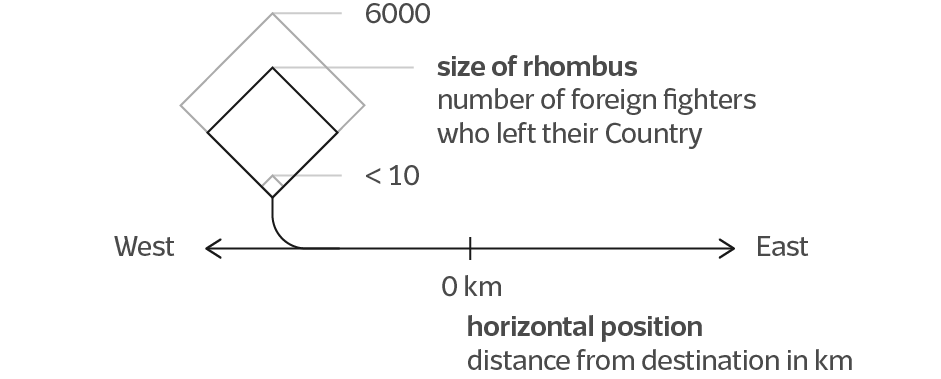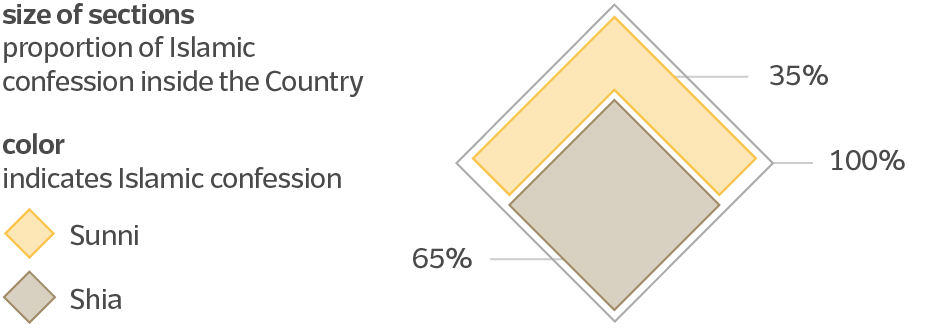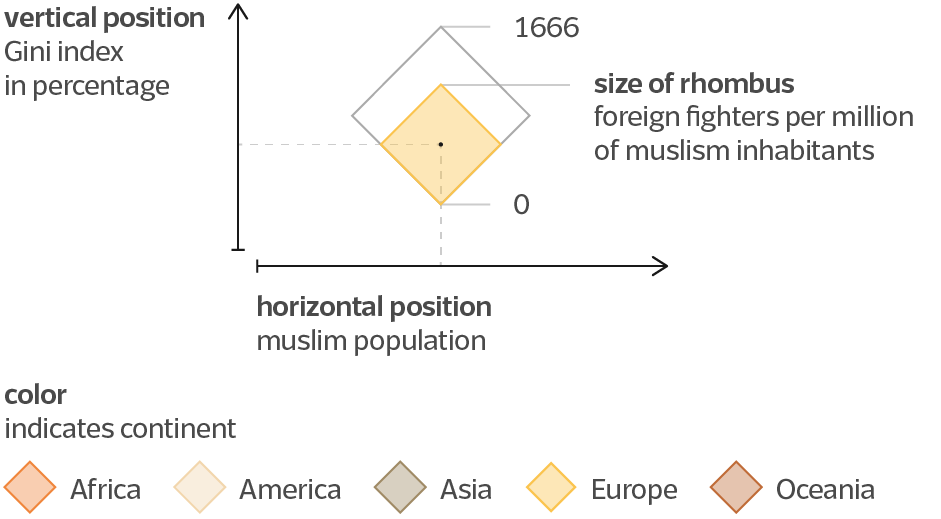Visual key
Each dot represents 5 foreign fighters. Color of the dot shows when personal data is available, in this case about gender.

Visual key
Each dot represents 5 foreign fighters. Color of the dot shows when personal data is available, in this case about gender.

More than 30,000 fighters have taken up the cause or have been forced to leave by the Islamic state
More than 83,351,800 km were covered to reach the conflict area
There is detailed information only about 2,887 foreign fighters
Foreign fighters are individuals that have, for a variety of reasons and with different (ideological) backgrounds, joined an armed conflict abroad. There are tens of thousands of fighters who left their own Country to reach the territories of Iraq and Syria, and ultimately take part in the conflict. They left their homes guided by the Jihad, namely «struggling,» a term that is originally interpreted, according to the sacred Islamic texts, as a profound push to improve the believer spiritually and culturally. In recent history, the term has been manipulated by those who instigate an Islamic «holy war,» assigning to it a distorted and violent meaning.
The Islamic state of Iraq and Syria (ISIS) is just one of several groups participating in the conflict. However, a highly polished and targeted propaganda, together with an extremist interpretation of the Islamic religion’s sacred texts, have brought thousands of proselytes among the ranks of the terrorist organization. The struggle for the creation of an Islamic state thus shifts from the political borders of Syria and Iraq to reach and involve the world at large.
Visual key
The squares below show how many foreign fighters traveled to the territories of the conflict. The value displayed with the size of each square is the number of fighters that left their country.

Click on rhombus to see values
Source: The Soufan Group
The construction of the Islamic state is supported by faith and by promises of an eternal life, however this bet requires the pledge of entrustment of the material life. To fight for life with a life. The idea of a world that shares a common law and a single faith transforms the feeling of marginality towards society in a profound sense of duty towards a different one that subjugates it. The «missing roots» are of whom feels lost within their own society and decides to search for them elsewhere.
Visual key
The call to join the terroristic group was answered by people all over the world, even from the most distant countries. On the map below, the position of each country reflects the geographical distance from each country to the destination. Countries to the left are located to the West from the destination territory; countries to the right are located to the East.

Scroll map horizontally

Sources: The Soufan Group, Wikipedia
The epicenter of the conflict is located in Syria and Iraq, but the war now involves neighboring countries and the entire international community. Pilgrimages to the territories of the clashes originates also from more regional contexts, which appear seemingly to be external to the cause of the Islamic state.
Like many other Islamic-inspired organizations, the ultimate goal of Daesh, acronym in the Arabic language for the ISIS group, is the establishment of its own interpretation of the Shari'a, the law of Allah. By them, a different order is not considered as possible. This is how religion becomes an instrument of legitimization of the attacks perpetrated by the fighters.
The war for the establishment of the Shari'a starts with foreign fighters in their country of origin, where the radicalization processes involves conversions to the Islamic religion, often for the so-called «last-minute converts.» These individuals, together with the muslims of second or third generation who decided to join the army of the Islamic state, chose the conversion to Islam in its most extreme form.
Visual key
You can see the relation of muslim population of a country to the number of foreign fighters that left from it. Countries are ordered by number of fighters and divided into three sections for secular, religious or ambiguous. Color helps to identify continents.




The war of the Islamic state is the last reflection of an internal dispute between Muslims that has been going on for centuries. During the Syrian civil war, which began in 2011, there has been a significant increase in the number of foreign fighters after the battle of Al-Qusayr in 2013, where their own imams and religious guides incited the respective masses of Shiites and Sunnis to act, consequently leading to the worsening of the already-unstable relations between the two groups. Belonging to one or the other faction means to identify on norms, customs and precepts that in this context often conduct to extremism and fanaticism.
Visual key
The next interactive graphics shows the distribution of Islam confessions of Shia and Sunni in Islamic countries. Values are normalized to 100% for each country.

Click on rhombus to see values
Source: Pew Research Center
Most of the foreign fighters are young, sometimes very young, second or third-generation Muslim immigrants living a strong sense of inadequacy, often determined by unemployment and integration obstacles. The war of ISIS’ militias represents for many of them a possibility of redemption, with the promise of improving their economic status within the society they live in.
The continuous increase of foreign fighters and the multiplication of the number of attacks by the hands of jihadists in the West, urge a reflection on the causes of this discontent and the difficulties of social integration. ISIS is well aware of this leverage and exploits these vulnerabilities for its direct benefits, directing the works of proselytism outside places linked to the Islamic environment. The new war of terror is fought with the English language, on the web, and follows a very precise and professional social media strategy. It is a brand built on terror, with a definite and consistent visual depiction of it.
Visual key
The interactive graph correlates the economic data of the Gini index and the muslim population of the countries. Each rhombus varies in size to show the ratio of foreign fightes to Muslim population: bigger size means more fighters over the country's Muslim population.

Gini index: index that measures the inequality in income distribution of a nation’s residents. It is a number between 0 and 1, where 0 corresponds to perfect equality and 1 (or 100%) corresponds to perfect inequality. Countries with a lower index are those where income is distributed more equally.
The economic data is not available for the following countries of study: Afghanistan, Algeria, Bahrain, Egypt, Iraq, Jordan, Kuwait, Lebanon, Libya, New Zealand, Qatar, Saudi Arabia, Singapore, Somalia, United Arab Emirates, Yemen.
Move mouse across graph
Please see interactive version on desktop

Since 2012, Europe and the Middle East have become the stage of bloody attacks against the population, seen from ISIS’ violent point of view as a mass of «infidels.» The virus of terror has spread to all countries. The feeling of insecurity derived from the impact of the attacks and the impossibility of knowing if, where and when a stroke could occur, has been leading the population to a constant state of alarm. Populistic policies and events of racist oppression against immigrants are consequences and reactions to this feeling, the concern of becoming a target when in fact, we have all been hit already.
Visual key
The map below shows the intensity and the number of the attacks that were claimed by ISIS in Europe and in the Mediterranean area between 2012 and 2015. Size of the rhombus represents the number of attacks, while color intensity the number of victims.

Click on map to see values
Foreign fighters are «stranger fighters» because they are strangers inside their own country. Disparities and marginalisation lead to a life lived on the edge. This can drive to going too far, crossing beyond not only physical borders but also those of civilization. The countries withstand the consequences of the pressure on their boundaries, they get distorted, deforming their original shape. Where de-form is the negation of beauty. We are facing a paradox: that journey to Mesopotamia, cradle of Civilization, is here translated into an involutionary path, which destroys and deletes from Time and History the passage of people in those lands. The Syrian civil war is a war of civilization, fought across the borders, now worn out, of all countries.
Visual key
The interactive map shows a deformed geography of the world. Each country was resized according to how many foreign fighters left over the Muslim population of the country. This ratio is expressed in parts per million.

Click on map to see values
This website is developed together with the printed visualization "The Journey of Foreign Fighters: on their way to Syria", published on La Lettura #266 on December 31, 2016. The map shows the movement of the foreign fighters from their country to the territory of the conflicts and those of them who came back. It was awarded at the Malofiej 25 Awards with "Best of Show" and Gold in the category "World and Nations," at the Kantar Information is Beautiful Awards 2017 with Gold in the category "Current Affairs & Politics," and finally earned the award "Studio of the Year" for DensityDesign Research Lab.
All the data used in this website is publicly available from the sources indicated below each visualization. You can download the specific dataset using the links next to the sources. Data about foreign fighters are published by The Soufan Group and by the International Centre for Counter-Terrorism – The Hauge; data about population of countries and religion are from the Pew Research Center; the economic data of the Gini index are from The World Bank; the secularity of the countries and the geographical distance are data extracted from Wikipedia; data about the attacks are available on the Global Terrorism Database.
The authors of this project curated the research, analysis and visualization of data, design and code development: , , , , .
The project was produced within the , Master Program in Communication Design at Politecnico di Milano. Faculty: Paolo Ciuccarelli, Marco Fattore, Stefano Mandato, Michele Mauri, Salvatore Zingale. Assistants: Angeles Briones, Azzurra Pini, Tommaso Elli, Michele Invernizzi.
Text by the authors, reviewed and approved by the editorial staff of Corriere della Sera.